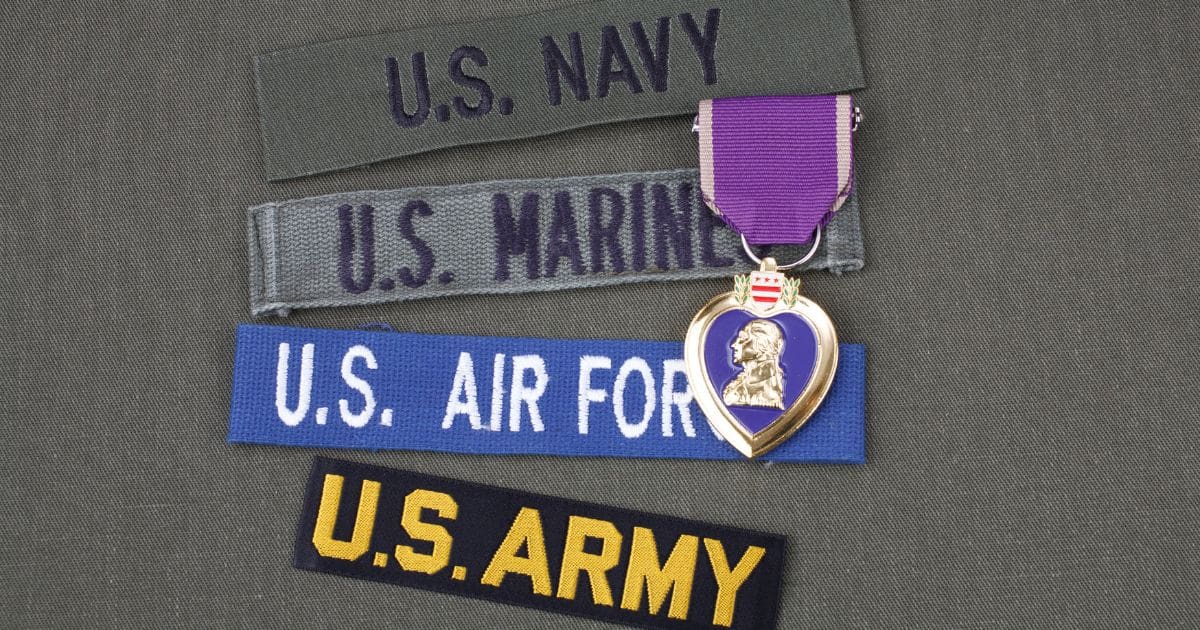What is the Purple Heart Award?
We often think of the Purple Heart Award as a modern-day military honor. Even though it’s officially linked to General Douglas MacArthur kicking things off in 1932, the roots of this medal extend back to the Revolutionary War!
The Purple Heart Award, celebrated each year on August 7th, holds the title for the oldest awarded badge in the US Military and the 1st military honor to be awarded to lower-ranking enlisted, non-commissioned soldiers.
The Origin of the Purple Heart Award
George Washington awarded the 1st Purple Heart shape badge to soldiers who fought in the Continental Army.
The criteria for Washington’s award was more about valor than injury therefore it was called the “Badge of Military Merit.” Washington’s motivation behind the award was to “fire up” the troops since morale was in sharp decline in 1782 due to disease and lack of supplies.
Only 3 soldiers were awarded the Badge of Military Merit, a hand-sewn simple purple cloth heart to be worn over the soldier’s left breast.
This non-descript no frills award may explain why it was forgotten for 150 years!

Resurgence of the Purple Heart Award in the 1930s
So in 1930, with the appointment of General MacArthur, came an announcement to revive the Washington merit badge to align with the bicentennial celebration of Washington’s birth.
Two years later on February 22, 1932, the Army announced the “Purple Heart” established by General Washington in 1782, would be “awarded to persons, who while serving in the Army of the United States, perform any singularly meritorious act of extraordinary fidelity or essential service.” In addition to extraordinary service, the award included those who were wounded in action as well… but it had to be a serious wound!
The other branches of the Armed Services need not apply, because only Army soldiers were eligible for the award!
In addition to snubbing the Navy and Air Force, MacArthur announced like Washington’s Badge of Merit, the Purple Heart, was “not intended to commemorate the dead, but to inspire the living.”
Originally, no posthumous acts of bravery were awarded.
The Evolution into Two Seperate Awards
The Army did have some serious catching up to do. From 1932 to 1941, they awarded a whopping 78,000 Purple Hearts to living veterans and active duty soldiers from World War 1, the Civil War, the Indian Wars, and the Spanish-American War.
Eligibility of the award continued to evolve.
After the attack on Pearl Harbor, and the US involvement in WWII, the Army decided to reevaluate the Purple Heart criteria.
In the end, in 1942, the War Department established 2 different awards.
The Legion of Merit honored those who demonstrated extraordinary bravery and the Purple Heart became exclusively an award for those “wounded or killed in action.”

Presidential Influence on the Purple Heart Award
The criteria of the award continued to adapt to the times. The world was changing so the current engagements, conflicts, and threats to the homeland impacted this criteria. Several Presidents jumped in and signed executive orders to accommodate those who they believed deserved recognition.
- 1942, President Roosevelt granted the Secretary of the Navy to award the Purple Heart to any eligible Navy, Marine, Air Force, and Coast Guard service member.
- 1962, President Kennedy, at the height of the Vietnam conflict, permitted any person wounded or killed “while serving with friendly foreign forces” eligible for a Purple Heart.
- 1984, President Ronald Reagan signed an executive order for those who were killed or wounded by “an international terrorist attack against the United States.”
- 2011, the Defense Department announced a Purple Heart will be awarded for those who suffer a brain injury as a result of IED explosions.
A Bittersweet Honor for True Heroes
It is a sad reality that many families are touched by this award. “Winning” it – and I say that loosely, is not a goal when a young man or women raised their right hand for service. It is an award every soldier and sailor would prefer not to own. It is a symbol of sacrifice , and it is a heavy one at that.
I reached out to several friends I knew who had family members who received this award. There was a dad who survived and a nephew who tragically died. But neither were up for talking about it. Just too darn painful.
For the dad, war memories were not exactly a place he wanted to visit. And the aunt was still feeling the sting of her nephew not making it back home. Despite the fact these recipients are the very definition of heroes, some wounds are just too raw to open up about.
Our company mission of “Protecting Those Who Protect Us” really hits home when I think about the sacrifice these Purple Heart recipients have made. Since 1932, over 1.8 million American men and women have been awarded the Purple Heart. These heroes who have been wounded or given their lives in service embody the very essence of protection.
At IR.Tools we aim to serve those who give so much for our freedoms. We take what we do seriously. Therefore, patch failure is not an option.
Each exclusive Sandstorm Technology™ patch is built with one seamless layer so it won’t fall apart and glows 250% brighter than standard honeycomb patches. We use the highest quality raw material and inspect each IR patch before it ships to its owner

A Legacy of Bravery and Sacrifice Connecting our Past and Present
While the Purple Heart medal still bears George Washington’s silhouette and likeness, its mission has certainly taken a winding journey. And while current criteria is far from General Washington’s original intentions, one must believe General Washington would be pleased with the bravery and sacrifice that continues to defend the nation he fought so valiantly to establish.


